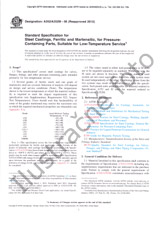Potrebujeme váš súhlas na využitie jednotlivých dát, aby sa vám okrem iného mohli ukazovať informácie týkajúce sa vašich záujmov. Súhlas udelíte kliknutím na tlačidlo „OK“.
ASTM E345-16
Standard Test Methods of Tension Testing of Metallic Foil
NORMA vydaná dňa 15.7.2016
Informácie o norme:
Označenie normy: ASTM E345-16
Poznámka: NEPLATNÁ
Dátum vydania normy: 15.7.2016
Kód tovaru: NS-646454
Počet strán: 5
Približná hmotnosť: 15 g (0.03 libier)
Krajina: Americká technická norma
Kategória: Technické normy ASTM
Kategórie - podobné normy:
Anotácia textu normy ASTM E345-16 :
Keywords:
ductility (elongation), metallic foil, specimen measurements (dimensions), specimen preparation, specimen type (A vs. B), speed of testing, strength (ultimate and yield), tension testing, uniaxial tensile stresses,, ICS Number Code 77.040.10 (Mechanical testing of metals)
Doplňujúce informácie
| Significance and Use | ||||||||||||||||
|
4.1 Tension tests provide information on the strength and ductility of materials under uniaxial tensile stresses. This information may be useful in comparisons of materials, alloy development, quality control, and design. 4.2 The results of tension tests from selected portions of a part or material may not totally represent the strength and ductility of the entire end product of its in-service behavior in different environments. 4.3 These test methods are considered satisfactory for acceptance testing of commercial shipments, since the methods have been used extensively for these purposes. 4.4 Tension tests provide a means to determine the ductility of materials through the measurement of elongation or reduction of area. However, as specimen thickness is reduced, tension tests may become less useful for determining ductility. For these purposes Test Method E796 is an alternative procedure for measuring ductility. 4.5 Different industries differentiate between foil and sheet at different thicknesses. Note 1: In 2013, to harmonize with international standards,
the Aluminum Association revised its definition of foil to include
thicknesses less than or equal to 0.2 mm (0.0079 in.).
4.6 This standard differs from Test Methods E8/E8M in that it permits determining the specimen thickness by weighing (7.3) and determining the elongation from crosshead displacement for some specimens (7.8). 4.7 It is impossible for this standard to define the thickness range for every possible alloy where this standard should be used instead of Test Methods E8/E8M or other tensile test standards. Superior results for a specific alloy and thickness could be obtained by measuring the specimen thickness by weighing (7.3) to avoid damaging the material and to obtain sufficient accuracy. In addition, it may be acceptable for a given alloy and thickness to determine the elongation from crosshead displacement in cases where conventional extensometers that contact the specimen or scribed fiducial marks could damage the specimen or affect the test results. |
||||||||||||||||
| 1. Scope | ||||||||||||||||
|
1.1 These test methods cover the tension testing of metallic foil at room temperature. Exception to these methods may be necessary in individual specifications or test methods for a particular material. 1.2 Units—The values stated in SI units are to be regarded as standard. The values given in parentheses are mathematical conversions to inch-pound units that are provided for information only and are not considered standard. 1.3 This standard does not purport to address all of the safety concerns, if any, associated with its use. It is the responsibility of the user of this standard to establish appropriate safety and health practices and determine the applicability of regulatory limitations prior to use. |
||||||||||||||||
| 2. Referenced Documents | ||||||||||||||||
|
Odporúčame:
Aktualizácia technických noriem
Chcete mať istotu, že používate len platné technické normy?
Ponúkame Vám riešenie, ktoré Vám zaistí mesačný prehľad o aktuálnosti noriem, ktoré používate.
Chcete vedieť viac informácií ? Pozrite sa na túto stránku.




 Cookies
Cookies
